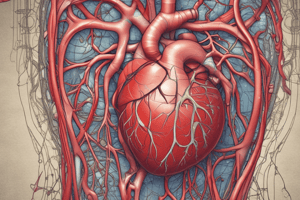Podcast
Questions and Answers
Which type of artery helps regulate blood pressure?
Which type of artery helps regulate blood pressure?
- Muscular arteries (correct)
- Elastic arteries
- Arterioles
- Venules
What is the primary function of capillaries?
What is the primary function of capillaries?
- To pump blood efficiently
- To regulate blood pressure
- To exchange oxygen and nutrients for waste products (correct)
- To carry oxygenated blood away from the heart
What is the term for the heart's ability to pump blood efficiently?
What is the term for the heart's ability to pump blood efficiently?
- Systemic circulation
- Blood pressure
- Pulmonary circulation
- Cardiac output (correct)
Which part of the heart separates the left and right sides?
Which part of the heart separates the left and right sides?
What type of valve separates the atria from the ventricles?
What type of valve separates the atria from the ventricles?
What is the term for high blood pressure?
What is the term for high blood pressure?
What is the primary function of the digestive system in relation to the cardiovascular system?
What is the primary function of the digestive system in relation to the cardiovascular system?
What is the term for the lowest pressure in the arteries between heart contractions?
What is the term for the lowest pressure in the arteries between heart contractions?
Which part of the heart is the inner lining?
Which part of the heart is the inner lining?
What is the term for the blood flow from the heart to the lungs, where it picks up oxygen?
What is the term for the blood flow from the heart to the lungs, where it picks up oxygen?
Flashcards are hidden until you start studying
Study Notes
Blood Vessels
- Arteries: Carry oxygenated blood away from the heart to the rest of the body
- Elastic arteries: Large, stretchy arteries that store energy from the heart's contractions
- Muscular arteries: Medium-sized arteries that help regulate blood pressure
- Arterioles: Small arteries that lead to capillaries
- Veins: Carry deoxygenated blood back to the heart
- Venules: Small veins that merge to form larger veins
- Large veins: Return blood to the heart
- Capillaries: Tiny vessels where oxygen and nutrients are exchanged for waste products
Blood Circulation
- Pulmonary circulation: Blood flows from the heart to the lungs, picks up oxygen, and returns to the heart
- Systemic circulation: Blood flows from the heart to the rest of the body, delivers oxygen and nutrients, and returns to the heart
- Cardiac output: The heart's ability to pump blood efficiently
Heart Structure
- Myocardium: The heart muscle itself
- Endocardium: The inner lining of the heart
- Epicardium: The outer lining of the heart
- Septum: The wall separating the left and right sides of the heart
- Valves: Ensure one-way blood flow through the heart
- Atrioventricular valves: Separate the atria from the ventricles
- Semilunar valves: Separate the ventricles from the pulmonary artery and aorta
Blood Pressure
- Systolic pressure: The highest pressure in the arteries during heart contractions
- Diastolic pressure: The lowest pressure in the arteries between heart contractions
- Hypertension: High blood pressure, a major risk factor for cardiovascular disease
- Hypotension: Low blood pressure, can cause dizziness and fainting
Human Digestive System (relation to cardiovascular system)
- Absorption of nutrients: The digestive system absorbs nutrients, which are then transported through the bloodstream to the heart and other organs
- Blood flow to digestive organs: The cardiovascular system supplies oxygen and nutrients to the digestive organs, supporting digestion and absorption
Blood Vessels
- Arteries carry oxygenated blood away from the heart to the rest of the body
- Elastic arteries are large, stretchy, and store energy from the heart's contractions
- Muscular arteries are medium-sized and help regulate blood pressure
- Arterioles are small arteries that lead to capillaries
- Veins carry deoxygenated blood back to the heart
- Venules are small veins that merge to form larger veins
- Large veins return blood to the heart
- Capillaries are tiny vessels where oxygen and nutrients are exchanged for waste products
Blood Circulation
- Pulmonary circulation involves blood flowing from the heart to the lungs, picking up oxygen, and returning to the heart
- Systemic circulation involves blood flowing from the heart to the rest of the body, delivering oxygen and nutrients, and returning to the heart
- Cardiac output refers to the heart's ability to pump blood efficiently
Heart Structure
- The myocardium is the heart muscle itself
- The endocardium is the inner lining of the heart
- The epicardium is the outer lining of the heart
- The septum is the wall separating the left and right sides of the heart
- Valves ensure one-way blood flow through the heart
- Atrioventricular valves separate the atria from the ventricles
- Semilunar valves separate the ventricles from the pulmonary artery and aorta
Blood Pressure
- Systolic pressure is the highest pressure in the arteries during heart contractions
- Diastolic pressure is the lowest pressure in the arteries between heart contractions
- Hypertension is high blood pressure, a major risk factor for cardiovascular disease
- Hypotension is low blood pressure, which can cause dizziness and fainting
Relation to Digestive System
- The digestive system absorbs nutrients, which are then transported through the bloodstream to the heart and other organs
- The cardiovascular system supplies oxygen and nutrients to the digestive organs, supporting digestion and absorption
Studying That Suits You
Use AI to generate personalized quizzes and flashcards to suit your learning preferences.





